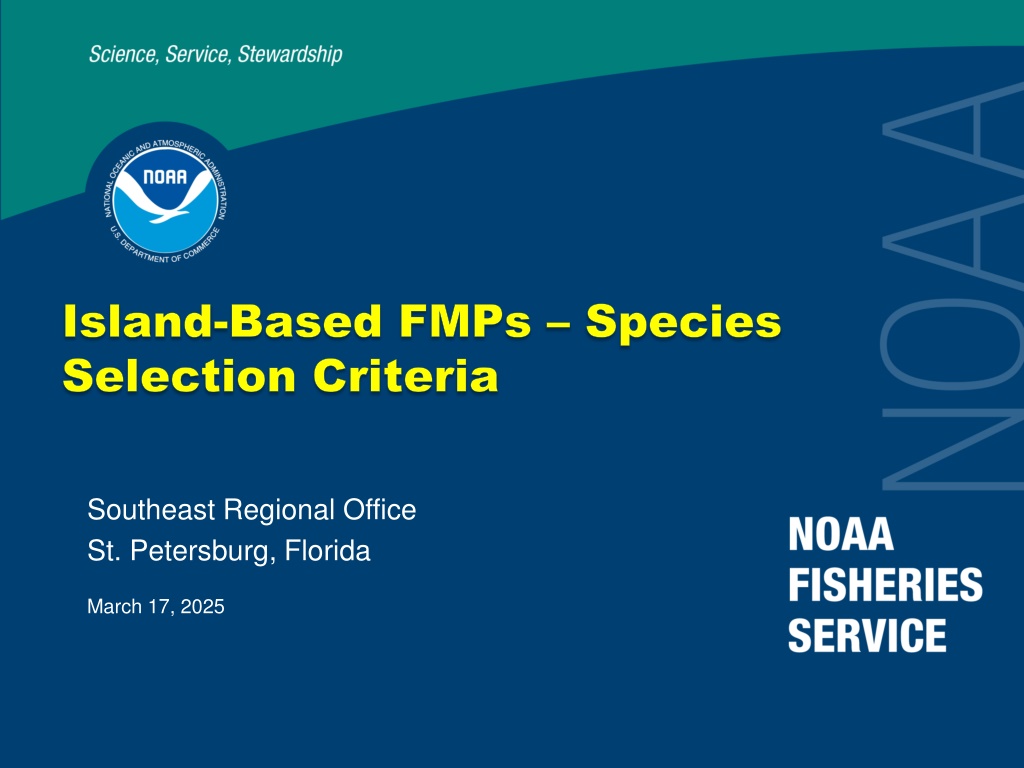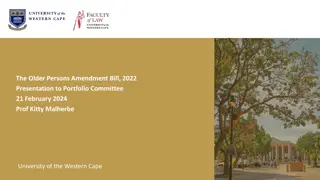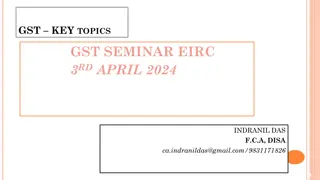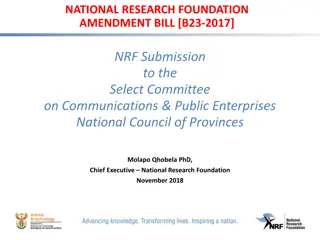
Fishery Management Plans and Species Selection Criteria Overview
Development of island-based fishery management plans (FMPs) is crucial for sustainable fishing practices. This overview discusses the criteria for species selection, including the Magnuson-Stevens Act (MSA) and National Standards (NS), management units, and draft criteria for inclusion/exclusion of species in FMPs.
Download Presentation

Please find below an Image/Link to download the presentation.
The content on the website is provided AS IS for your information and personal use only. It may not be sold, licensed, or shared on other websites without obtaining consent from the author. Download presentation by click this link. If you encounter any issues during the download, it is possible that the publisher has removed the file from their server.
E N D
Presentation Transcript
Island Island- -Based FMPs Based FMPs Species Selection Criteria Selection Criteria Species Southeast Regional Office St. Petersburg, Florida March 17, 2025
Development of island-based fishery management plans (FMPs) Development of FMPs is guided by the Magnuson- Stevens Act (MSA) and the 10 National Standards (NS). Both the MSA and the NSs provide guidance to determining what species should be included in an FMP: NS1 Achieve optimum yield and avoid overfishing NS3 Manage stocks as a unit NS7 Minimize costs, avoid duplication 2
Fishery Management Units (FMUs) vs. Species Current managed species are grouped in FMUs except spiny lobster and queen conch. Removed from Management Currently (e.g., parrotfish, snapper unit 1,2,3,4, groupers, angelfish, spiny lobster, aquarium trade species) Entire FMUs (e.g., parrotfish, snapper unit 1, aquarium trade species, squirrelfish) Added to Management Selection criteria will be applied to presently managed FMUs and presently not managed individual species Individual species (e.g., mahi mahi, snook, king mackerel) 3
First Step Take an initial look at what species need management Yes Use the proposed dichotomy model 4
Draft criteria to use in inclusion/exclusion of species or species complex in an FMP Species/ Species Complex Range (Geography) Yearly Mean Landings Protected/ Managed Resource Habitat Specificity Economic Importance Target Species Ecological Value Biology Bycatch Spiny Lobster L L H VH VH M H H? M H (PR, STX); M (STT) Dolphin Fish M (PR) H (STT/STX) L (PR) L (STX) L (STT) L L H H L M M Octopus M M M H L M L L Snapper Unit 2 (Queen & Cardinal) ? ? ? ? ? ? ? ? ? L = low, M = medium, H = high, VH = very high, ? = to be determined PR = Puerto Rico, STT = St. Thomas, STX = St. Croix 5
Criteria definition Biology - defined as question of vulnerability/productivity. Is species particularly at risk? Application of the Only Reliable Catch Stocks ? Habitat Specificity - defined as a question of vulnerability due to particular dependence on limited or vulnerable habitat during some life stage. Range - defined as whether species is either 1) effectively limited to local waters, 2) limited to EEZ, 3) spans both, or 4) is a migratory species or coastal pelagic. Used up-front to eliminate those species only occurring in State waters, so using again in the selection criteria table may be redundant. 6
Criteria definition - continued Economic Importance - defined as total economic value, not just ex- vessel price. This would include, for example, nonconsumptive use, recreational value, targeted species, filler species and socio-cultural importance. Target Species vs. Bycatch- Species that fishers seek to catch for sale or personal use, including economic discards as defined under the Magnuson-Stevens Act. Landings are used up-front to establish lower and upper thresholds for automatic rejection from or inclusion in an FMP, respectively. Including them again in the selection criteria table may be redundant. 7
Criteria definition - continued Bycatch - Fish other than the primary target species that are caught incidental to the harvest of the primary species. Ecological Value - defined as having a unique or large ecological function relative to habitat (esp. coral reefs), or trophic/community structure, e.g., keystone species, apex predator, key forage species such that management is needed to sustain that function. Protected/Management Status - defined as whether the species is fully protected or partially protected within an existing management framework within EEZ or local waters. Used up-front as a fundamental selection criterion. Using again in the selection criteria table is redundant. 8
24. OCTOPUS* 25. TUNNY, LITTLE 26. SHARKS, REQUIEM* 27. PORGIES* 28. SNOOK, COMMON 29. MOJARRAS* 30. GROUPERS* 31. JACKS* 32. SNAPPER, CARDINAL 33. FISHES, BONY* 34. SNAPPER, VERMILION 35. WAHOO 36. SQUIRRELFISHES* 37. TUNA, YELLOWFIN 38. CRAB, BLUE LAND 39. GROUPER, MISTY 40. GRUNTS* 0-60% 1. LOBSTER, CARIBBEAN SPINY CONCH, QUEEN SNAPPER, SILK SNAPPER, QUEEN SNAPPER, YELLOWTAIL DOLPHIN SNAPPER, LANE 2. 3. 4. 5. 6. 7. Using landing thresholds - % of total species complex or single species landings for Puerto Rico (2008-2012 landings) >60-95% 8. 9. 10. PARROTFISHES* 11. TRIGGERFISH, QUEEN 12. HERRINGS, SARDINELLA 13. GRUNT, WHITE 14. BOXFISH 15. SNAPPERS* 16. SNAPPER, MUTTON 17. BALLYHOO 18. JACK, BAR 19. HIND, RED 20. TUNA, BLACKFIN 21. CERO 22. TUNA, SKIPJACK 23. MULLET, WHITE MACKEREL, KING HOGFISH >95-100% 41. SNAPPER, BLACKFIN 42. JACK, HORSE-EYE 43. CONEY 44. DOLPHINS 45. SHELLFISH, OTHER* 46. GOATFISH, SPOTTED 47. BARRACUDAS* 48. ALBACORES* 49. SNOOKS* 50. CRAB 0-60% 7 >60-95% 40 >95-100% 50 9 *species complex
29. SURGEON, OCEAN 30. SNAPPER, QUEEN 31. DOCTORFISH 32. SNAPPER, MAHOGANY 33. WENCHMAN 34. TUNA, YELLOWFIN >95-100% 0-60% 1. 2. 3. 4. 5. 6. 7. 8. 9. 10. HIND, RED 11. PARROTFISH, REDTAIL 12. PARROTFISH, REDBAND LOBSTERS, SPINY PARROTFISH, STOPLIGHT DOLPHIN CONCH, QUEEN TRIGGERFISH, QUEEN PARROTFISH, PRINCESS WAHOO PARROTFISH, QUEEN PARROTFISH, REDFIN 35. SCAD, ROUND 36. ANGELFISH, QUEEN 37. GRUNT, FRENCH 38. RUNNER, BLUE 39. TUNA, BLACKFIN 40. COWFISH, HONEYCOMBED 41. HONEYCOMB COWFISH 42. BARRACUDAS* 43. SNAPPER, VERMILION 44. TUNA, SKIPJACK 45. GROUPER, YELLOWFIN 46. LIONFISHES 47. HERRINGS* 48. HERRINGS, SARDINELLA 49. SNAPPER, LANE 50. SQUIRRELFISH, LONGSPINE 51. TOMTATE 52. TRUNKFISH, SPOTTED 53. SHARK, NURSE 54. JACK, HORSE-EYE Using landing thresholds - % of total species complex or single species landings for St. Croix (2012-2013 landings) >60-95% 13. SNAPPER, BLACKFIN 14. BALLYHOO 15. TUNNY, LITTLE 16. MACKEREL, KING 17. SCHOOLMASTER 18. SNAPPER, SILK 19. CONEY 20. GRUNT, BLUESTRIPED 21. JACK, BAR 22. TANG, BLUE 23. GRUNT, WHITE 24. SNAPPER, YELLOWTAIL 25. SNAPPER, GRAY 26. SNAPPER, MUTTON 27. ANGELFISH, FRENCH 28. ANGELFISH, GRAY 0-60% 12 >60-95% 34 >95-100% 54 10 *species complex
0-60% >95-100% 1. 2. 3. 4. 5. 6. LOBSTERS, SPINY TRIGGERFISH, QUEEN HIND, RED RUNNER, BLUE SNAPPER, YELLOWTAIL ANGELFISH, GRAY 26. GROUPER, YELLOWFIN 27. TRIGGERFISHES 28. TUNA, BLACKFIN 29. GRUNT, BLUESTRIPED 30. TANG, BLUE 31. ANGELFISH, QUEEN 32. ANGELFISH, FRENCH 33. NEEDLEFISHES* 34. BALLYHOO 35. RUNNER, RAINBOW 36. HERRINGS* 37. HERRINGS, SARDINELLA 38. COWFISH, HONEYCOMBED 39. HONEYCOMB COWFISH 40. TUNA, YELLOWFIN 41. TOPSNAIL, WEST INDIAN 42. MARGATE 43. CRAB 44. SNAPPER, LANE 45. SCHOOLMASTER Using landing thresholds - % of total species complex or single species landings for St. Thomas/St. John (2012-2013 landings) >60-95% 7. 8. 9. 10. SCRAWLED COWFISH 11. PORGY, SAUCEREYE 12. SQUIRRELFISH, LONGSPINE 13. PARROTFISH, REDTAIL 14. SNAPPER, MUTTON 15. PARROTFISH, STOPLIGHT 16. JACK, BAR 17. DOLPHIN 18. SNAPPER, BLACKFIN 19. TUNNY, LITTLE 20. LIONFISHES 21. WAHOO 22. CONEY 23. SNAPPER, SILK 24. HOGFISH 25. MACKEREL, KING DOCTORFISH GRUNT, WHITE COWFISH, SCRAWLED 0-60% 12 >60-95% 25 >95-100% 45 *species complex 11
Questions? 12
Different Variations in the Nomenclature used to Name Managed Species/ Species Groups Snapper Unit 2 (SU2): Cardinal and Queen Snappers used as an example. CURRENT FMPS NS1 STATUS OF THE STOCKS SU2 = FMU and part of the snapper complex SU2 = stock complex SU2 = stock unit Queen and Cardinal snappers = units within the FMU Queen and Cardinal snappers = stocks within the stock complex SU2 = Unit However, the 2011 species are called stock complex (e.g., Angelfish Complex) SU2 is part of the snapper complex within the Reef Fish FMU SU2 unit part of the Caribbean Reef Fish FMU SU2 unit part of the Caribbean Reef Fish FMU U.S. Department of Commerce | National Oceanic and Atmospheric Administration | NOAA Fisheries | Page 13






















